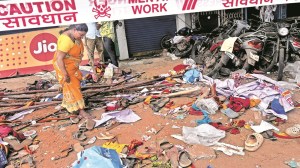Click here to follow Screen Digital on YouTube and stay updated with the latest from the world of cinema.
‘Nobody asks your caste or religion on a film set’: Shahana Goswami
The lead actor of Santosh, the Sandhya Suri-directed cop drama shortlisted in the International Feature Film category at Oscars 2025, on the moral greys that make her role shine.
 Santosh, the 2024 film directed by debutant Sandhya Suri, was recently shortlisted in the International Feature Film category at the Oscars.
Santosh, the 2024 film directed by debutant Sandhya Suri, was recently shortlisted in the International Feature Film category at the Oscars.Days after Santosh is signed into the police force after her husband’s death in the line of duty, she realises that his profession — one exalted by his family, community and world at large — is not just littered with a few bad apples, but rotten to the core. She is standing in a police station corridor, having just witnessed a girl file an FIR against a boy who allegedly promised her marriage after sex (he denies being anything more than a friend), when she hears grunts and cries from a nearby cell. She peeks in and sees the girl slap and scream at the boy as he is held in place by burly police officers. Later, she sees a bribe exchange hands, a thanks for letting her have at him before legal action.
This scene appears early in Santosh, the 2024 film directed by debutant Sandhya Suri that was recently shortlisted in the International Feature Film category at the Oscars. It’s about the eponymous character’s gradual disillusionment with a job she once respected. “None of us have a steady moral compass,” says Shahana Goswami, who plays the lead. “That’s the human experience, of figuring out your moral compass. What I found interesting about Santosh was that she’s still in that process, and sometimes it’s conflicting, as in life. Sometimes there’s awareness of it, sometimes not.”
Every time it seems like the film is headed for a trope — a female victim of sexual violence unable to find proof of assault, an upper-caste administration complicating the investigation of a Dalit girl’s rape and murder, misogyny in working-class spaces — the rug is pulled out from under the audience. A fresh scene forces you to complicate your loyalties: a girl beating her assaulter with the police’s help because she knows the system is biased against her; a Dalit man who screams at Santosh, an upper-caste policewoman, for daring to interrogate his community when she can’t even “drink our village’s water”; her flirting with a man to make him rat on his friend, a Muslim murder suspect in a town hungry for minority blood.
“Santosh is designed to be an observer,” says Goswami. “You get a voyeuristic feeling watching the film… Sandhya is a keen observer of reality and was instrumental in shaping the characters to be understated and matter-of-fact. (In depicting) these situations, we may feel the need to over-dramatise them because we haven’t been in them ourselves. But Sandhya spent a lot of time with police officers and saw a certain nonchalance because that’s daily life (for them).”
A particularly difficult scene to shoot involved torture, in which Santosh and her colleagues are violently interrogating the Muslim suspect. This is the climax of Santosh’s descent into her profession’s underbelly, wherein undertrials are waterboarded in the dark, confessions are forced under duress, overworked police officers punch their way out of frustration. “There was a lot of nervousness around that scene,” says Goswami. “Physical violence is something I have a certain reaction to. I’m not very good with it. But I think that lent itself to the scene because Santosh is also feeling pressure to act in a certain way and finds some catharsis and — I don’t want to say pleasure — release in that aggression.”
“Sharma is much more confident in these morally grey spaces,” says Goswami, referring to the senior policewoman, played by Sunita Rajwar, who appears halfway into the movie as Santosh’s polar opposite: bossy, foulmouthed and breezily swigging drinks next to men who love sexist jokes. “There’s a natural reaction one has to authority, and it’s not like Santosh isn’t feisty or defiant. (It’s just that) you’re seeing her in a different phase in her life when she is exceptionally vulnerable… in a new world where she’s completely out of her depth. When Sharma comes into that universe, Santosh initially (thinks it’s another) intimidating space, then finds some sense of emulation, then gets validation from her, which probably adds to her taking on more charge.”
This story of authority and identity isn’t confined to police stations. The Indian film industry has historically favoured rich, Hindu and upper-caste men. But, says Goswami, “I can only say that in my experience of all film sets, they’re one of those utopian spaces where everything disappears. You could have people from different religions, different classes, different castes, and none of it matters. Nobody cares about or even asks about these things. There’s not just leeway but so much respect and space given to any kind of diversity that exists. Even other aspects that may have been spoken about openly earlier, in terms of differences between men and women… from the time I’ve been part of it, I haven’t felt that differentiation.”
“On a unit, there is a larger madness that everybody is held together by,” she adds. “I’ve always been someone who’s been very open — sometimes naively ignorant and sometimes deliberately blind to any kind of difference. I like to be able to play that out and I’ve never felt misconstrued… Especially in independent films, it’s not like the money is so great… you could make a lot more by doing something steady (like work) in a bank… but people choose to do this because there’s a kind of mad fun in it which is addictive.”


- 01
- 02
- 03
- 04
- 05
































